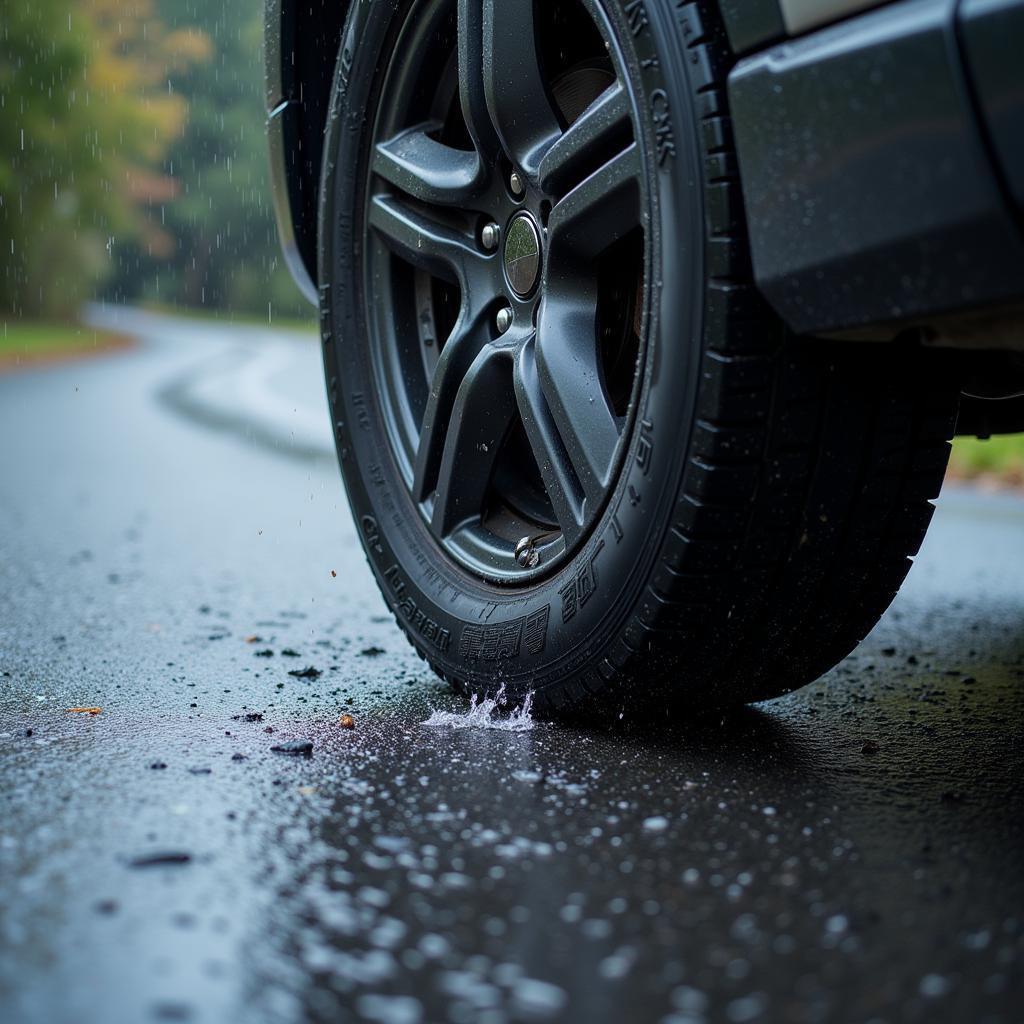Imagine this: you’re driving down the road, and suddenly, your car feels like it’s floating, sliding, or even skating on ice. It’s a terrifying feeling that can lead to a loss of control and potentially dangerous situations. But what causes a car to feel like it’s sliding on ice, and more importantly, what should you do if it happens to you?
Several factors can contribute to this unsettling driving experience, ranging from slippery road conditions to mechanical issues. Understanding these causes is the first step in addressing the problem and ensuring your safety on the road. Let’s delve into the common culprits behind that “sliding on ice” sensation:
Slippery When Wet: It’s All About Traction
The most obvious reason your car might feel like it’s gliding on ice is, well, ice. Black ice, in particular, is a driver’s nightmare. This thin, transparent layer of ice on the road can be nearly invisible to the naked eye, making it a serious hazard, especially in colder climates.
But ice isn’t the only culprit. Wet roads, regardless of the temperature, pose a significant risk. When water mixes with oil and grime on the road surface, it creates a slippery film that reduces tire traction. This loss of grip makes it harder for your car to steer, accelerate, and brake effectively, leading to that “sliding” sensation.
 Car Tire Skidding on Wet Road
Car Tire Skidding on Wet Road
Beyond Slippery Surfaces: Mechanical Culprits
While slippery roads are the usual suspects, sometimes, the issue lies within your car’s mechanics. Worn-out tires, for instance, lack the necessary tread depth to channel water away from the contact patch – the area where the tire meets the road. This can lead to hydroplaning, where your tires lose contact with the road surface and ride on a thin layer of water, making your car feel like it’s floating.
A failing or malfunctioning anti-lock braking system (ABS) can also contribute to this unsettling feeling. The ABS is designed to prevent your wheels from locking up during hard braking, allowing you to maintain steering control. However, a faulty ABS system may not engage properly, causing your wheels to lock and skid, especially on slippery surfaces.
Other mechanical issues that can contribute to a “sliding on ice” feeling include:
-
Worn Suspension Components: Worn shocks, struts, or ball joints can affect your car’s handling and stability, making it feel loose and unpredictable, particularly on uneven or slippery roads.
-
Misaligned Wheels: Improper wheel alignment can cause your car to pull to one side or feel unstable, especially at higher speeds. This instability can be amplified on wet or icy roads, leading to a sensation of sliding.
-
Low Tire Pressure: Underinflated tires can significantly reduce tire contact with the road surface, decreasing traction and increasing the risk of hydroplaning and skidding.
What to Do When Your Car Feels Like It’s Sliding on Ice
Experiencing that sudden loss of control can be panic-inducing, but it’s crucial to stay calm and act decisively. Here’s what to do if your car feels like it’s sliding on ice:
-
Don’t Panic: Easier said than done, but keeping a clear head is essential. Panicking can lead to overreacting, which could worsen the situation.
-
Ease Off the Gas: Accelerating will only exacerbate the loss of traction. Gradually reduce speed by gently releasing the gas pedal.
-
Don’t Slam on the Brakes: Slamming the brakes can lock up your wheels, leading to a complete loss of control. Instead, apply steady, even pressure to the brakes. If your car has ABS, you might feel a pulsing sensation – this is normal and indicates the system is working.
-
Steer in the Direction You Want to Go: If your car starts to skid or slide, turn the steering wheel in the direction you want the front of the car to go. This is called “steering into the skid.”
-
Be Prepared to Counter Steer: As your car begins to regain traction, be ready to turn the steering wheel back in the opposite direction to prevent overcorrecting and potentially spinning out.
 Driver's Hands Gripping Steering Wheel During Skid
Driver's Hands Gripping Steering Wheel During Skid
Prevention is Key: Staying Safe on Slippery Roads
While knowing how to react in a skid is crucial, preventing such situations in the first place is always the best approach. Here are some proactive measures to help you stay safe on slick surfaces:
-
Check Your Tires: Regularly inspect your tires for wear and tear, ensuring adequate tread depth. Replace worn tires promptly.
-
Maintain Proper Tire Pressure: Check your tire pressure regularly, including the spare tire, and inflate them to the recommended levels specified in your car’s owner’s manual.
-
Slow Down: Reduce your speed when driving on wet or icy roads. This gives you more time to react to changing road conditions and reduces the risk of losing control.
-
Increase Following Distance: Maintain a safe following distance from the vehicle ahead, especially in slippery conditions. This provides ample braking distance if the car in front of you stops suddenly.
-
Be Aware of Your Surroundings: Pay close attention to the road surface and be on the lookout for potential hazards like puddles, ice patches, and areas prone to black ice formation.
-
Consider Winter Tires: If you live in an area with frequent snow or ice, consider investing in winter tires. These tires are specifically designed for optimal grip and performance in cold and snowy conditions.
When in Doubt, Pull Over: Your Safety First
Driving on slick roads requires extra caution and attention. If you’re ever unsure about road conditions or feel uncomfortable continuing, it’s always best to pull over to a safe location and wait for conditions to improve. Your safety should always be your top priority.
Need Help? We’re Here for You!
If you’re experiencing persistent car trouble or have concerns about your vehicle’s handling, don’t hesitate to reach out to our team of experts. At VNG Game, we’re dedicated to keeping you safe on the road. Contact us at 0902476650 or email us at [email protected]. Our 24/7 customer support team is always ready to assist you. You can also visit us at 139 Đ. Võ Văn Kiệt, Hoà Long, Bà Rịa, Bà Rịa – Vũng Tàu, Vietnam.





